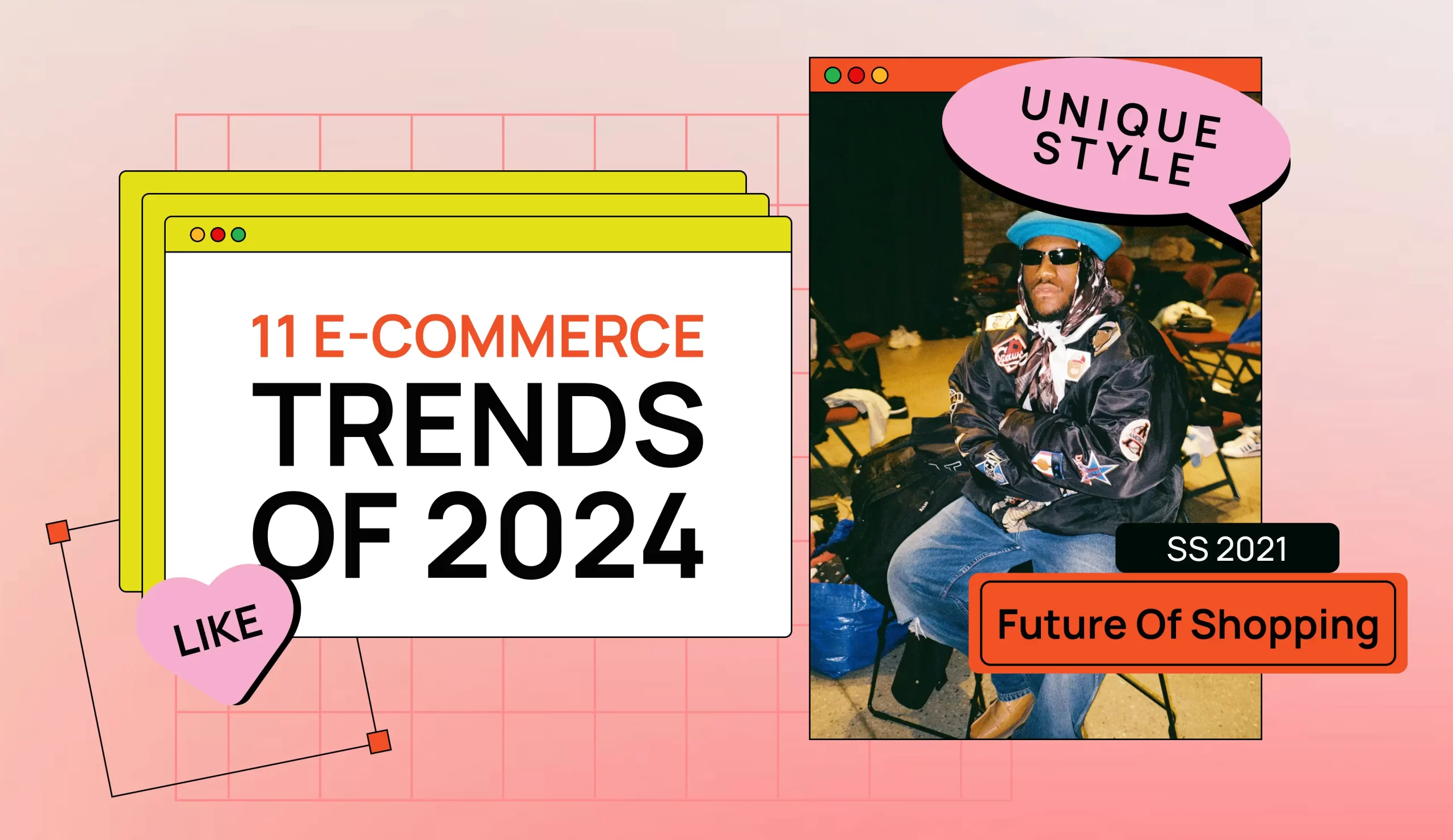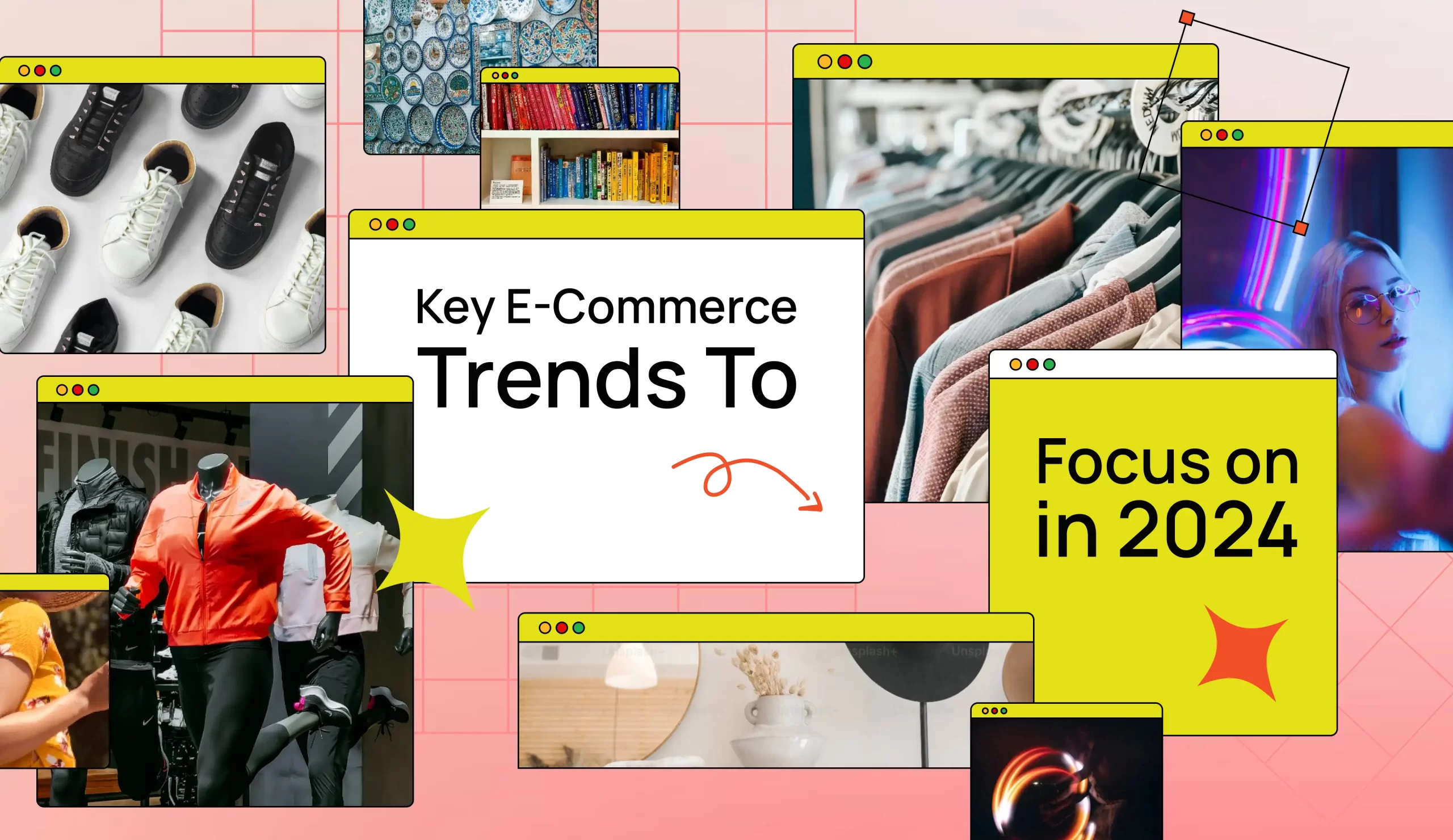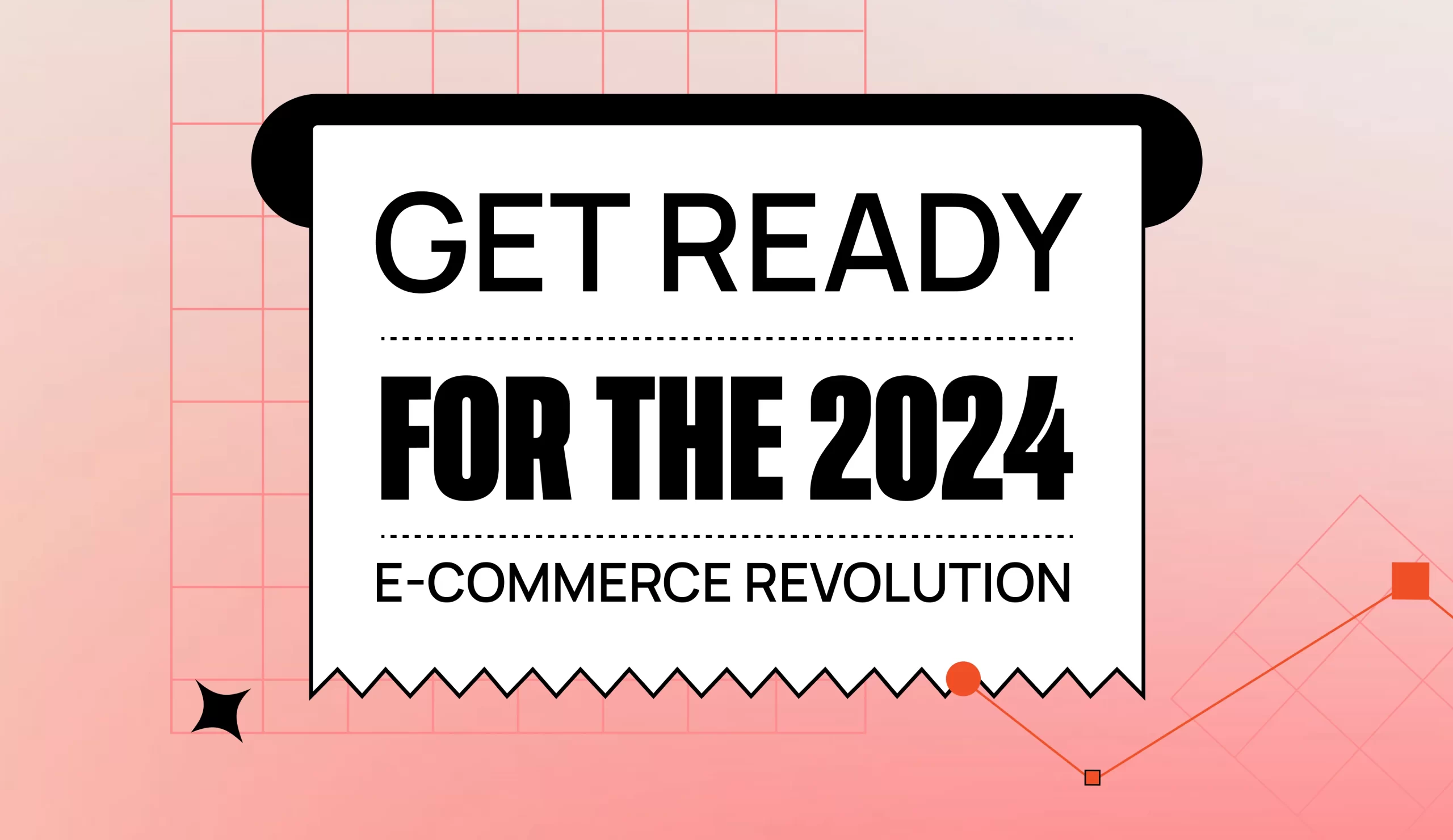Pixbrand Team
Published: 31/01/2023
- App Development
- Digital Marketing
- Ecommerce
- Seo
- shopify
- UI/UX Design
- Web Development
- woocommerce

It’s time to put brick and mortar stores out of business because e-commerce is poised to shine in 2024 dressed in a holographic gown. The era of dusty shelves, abandoned carts, and interminable aisles is over. Now, you may purchase online from the comfort of your coach in a personalized way.
The US e-commerce industry is predicted to generate over $900 billion in revenue by 2023 and reach $1 trillion by 2028. This remarkable expansion can be attributed to adhering to e-commerce patterns and keeping up with the constantly evolving preferences and actions of customers.
eCommerce trends for 2024 will combine online and physical shopping with cutting-edge technologies like chatbots, automation, augmented and virtual reality, and machine learning. a real-time online shopping experience that allows you to easily find in-store products and benefit from AI recommendations based on past purchases.
In 2024, a new e-commerce age defined by innovation and personalization will dawn, redefining what it means to make an online purchase without facing hassles or frustration.
Why Embracing E-commerce Trends Benefits Every Business?
The world of e-commerce is always changing, so if you ignore trends, you’re just avoiding using the current AI and having to do everything by hand, which wastes time. Keeping up with e-commerce trends helps you keep one step ahead of your rivals, take advantage of technological advancements, and enhance your customers’ buying experience.
Let’s say a customer needs assistance setting up the decor in her restaurant. Your AR/VR integration can let her see how the furniture will mix in with the other interior aspects.
Online retail businesses make purchasing more convenient, and between 2023 and 2032, the industry is expected to rise by more than $57 trillion.
Along with the B2B e-commerce website sales expected to reach $36.1 trillion in 2031, customer demands are rising too.
With technological advancement, acquiring new customers will be 7X times more challenging and expensive in the coming decade. Following the ecommerce predictions of trends will make you more user-centric and ease the process of retaining customers too.

Key E-Commerce Trends To Focus on in 2024
1. Captivating Attention with Short-form Video
With TikTok and Instagram reels, short-form video content is the new king of content and will continue to slay the digital commerce trends in 2024. What would you like to invest your time in – a dry long description or a video that can showcase your brand in just 60 seconds? By 2026, the revenue from short-form videos will touch %566 billion.
Short-form video’s magic is all about bite-sized clips that instantly hook viewers, cutting through information and triggering instant engagement. The videos give you a chance to humanise your brand and build trust. The creativity in the video content has a significant impact on its success of conversion.
Even accounts with fewer followers on social media can reach out to the mass audience as platforms boost the short video content. Such content goes viral fast. A golden chance to showcase all the features, and benefits of your product just like any movie teaser.
2. Shopping and Socialising at one time with Social Commerce
If you are considering social media a mere source of entertainment, then you are missing a chance to sell your products to a wider audience. Social commerce is the current trend in ecommerce and will be ruling the world of shopping in 2024 too.
It’s filling the blurred lines between browsing and buying, turning product discovery into a fun experience. The shoppable posts and quick checkout process eliminate the friction and allow impulse purchases.
42% of social media users are comfortable sharing their credit card information with such platforms. The visuals and product catalogue are more personalised as per the user’s taste. By 2025 the global social commerce market will be $3.3 million.
Why use social media platforms like Instagram, TikTok or Meta for marketing and branding only? Give direct shopping leverage and let them feel a part of the community.
3. Shifting with Customer Preferences – Mobile over Desktop
Your business will fail in 2024 if your e-commerce site is not mobile-friendly. Because 75% of shoppers use their mobiles compared to 15% using desktop and 6% using tablet. Today customers like to shop on the go and mobile gives them the freedom to buy things with a seamless payment system.
The frictionless payments, an opportunity to connect with brands and an increase in in-store sales are some of the primary reasons why mobile commerce will be the next big thing.
A customer keeps her/his phone everywhere whether going on vacation, office, or family function. If your e-commerce website fails to load or engage with your customers on mobile; you are losing the mass crowd who shops via mobile.
Starbucks launched its mobile order and pay app in 2015; by 2021, 26% of all orders were paid by mobile.

4. Personalising Customer Support with Direct Messages
Would you rather DM or write a mail to raise a query about a product or service? DM must be the answer. It is the rising star of e-commerce customer service and how a brand connects with its consumers. No one has long hours to invest in raising a query and then take it to the higher authority. Every consumer wants an instant response to their query.In 2023, over 19% of consumers seek out help via DMs.Social media platforms like Instagram, Meta, and Twitter are prioritising personalised interaction and making DM accessible to all for better communication.
Moreover, delaying the response towards customer queries leaves a negative image and reduces the chances of customer retention. As every business’s primary goal is customer satisfaction, direct messages open a gate to building relationships with a friendly connection.
Invest in CRM software to manage multi-channel interactions effectively and track the inquiries to enhance your service.
5. Sustainable Packaging for Conscious Consumer Demands
Running a business is not only about selling a product/service and providing a rich user experience but also about fulfilling the equal responsibility towards nature as a brand. Today, consumers want to buy something from a brand that is consciously integrating an eco-friendly approach to produce and distribute their products.And sustainable packaging is one of the trends that will keep evolving every year. 37% of consumers are ready to pay more for eco-friendly packaging and 54% of them invest in a brand that is willing to support society on a social and eco-friendly level.
As this conscious choice to save nature is increasing, by 2026 the sustainable packaging market will reach up to $382.8 billion.
It not only builds trust among customers but also saves the costs and waste that goes into packaging. Ensure that if you run a business or planning to do so, use biodegradable material, keep the design minimum and focus on reusing the material to make your contribution to saving the environment. However, it’s not a trend, it is a choice that one should always make.
6. Augmented Reality and Virtual Reality
AR and VR is no longer a premium feature, it is a must-have to give a real-time experience to the consumers before buying a product. This will be a primary feature of the Fashion and home Decor industry in 2024 so that customers can visualise how the product will turn out when executed.As per the research report of Grand View Research and Stastia, the AR market will touch the market of $61.48 billion and VR will project a hit of $47.45 billion by 2025.
AR and VR increase the conversion rates as the customers get a chance to experience the product. Also, it will build a stronger connection fostering brand loyalty and advocacy. It gives you insight into what kind of products are ruling the shopping cart of consumers and where is the scope of improvement.
By installing it in the stores, optimising it for mobile devices and blending it with shopping carts, as an e-commerce you can unleash its true potential. It’s not merely an advanced technology to stand out from the crowd, but to step into the virtual world to captivate them with your products.
7. Image Search for Visual Discovery and Streamlined Shopping
Ever liked something in a store or somewhere on the expensive brand page, but then failed to find it online? No matter what kind of keywords you use, it is not easy to find the exact product online. Image search will be the ice-breaker in eCommerce business trends.Image search not only helps to find the exact product but also helps to discover something similar in different ranges and styles. Moreover, it makes the search experience easy for those who don’t know the language and keywords to find a particular product.
Pinterest is the most aesthetic platform from which customers seek inspiration to style outfits, decor homes or DIY things. Users often hunt those perfect pins on the e-commerce platform and if you have this option, you can provide a rich user experience.
Fashion brand ASOS uses innovative image recognition technology to find similar clothing. It is a way to stand out in 2024 with your ecommerce business
8. ML and AI for Personalised Shopping Experience
Machine Learning and AI are already levelling up the game of user experience in day-to-day life. You might not observe it, but ML & AI are mostly in everything you use a device, website or movie streaming platform.AI is not only to give recommendations but also help to prevent online fraud. Today customers prefer a brand that can personalise their shopping experience.
Relevant content and product recommendations keep users hooked, boosting the trust among customers. Personalised marketing reduces the chances of showing irrelevant ads to customers and also increases the conversion rate as they buy exactly what they want.
Amazon, Netflix and Shopify suggest the relevant product, most common shows streamed in a category and music playlist to keep the customers hooked to the platform.
Both ML and AI are the advanced technologies used in e-commerce to ensure that the customer stays with the platform/brand for a longer time.
9. ROPO (“Research Online, Purchase Offline”)
Are you wondering how digital efforts can translate or improve your offline sales? There is a tool called Research Online, Purchase Offline (ROPO) that will be ruling 2024 e-commerce trends in 2024 to help retailers analyse how digital advertising and marketing contribute to in-store sales.ROPO collects data from social media, mobile tracking, geolocation, mobile payments, inventory systems, analytics tools and CRM systems to analyse which website page/advertisement leads consumers to purchase from a physical store.
This data gives insight into the advertisement and marketing efforts that are working most effectively for offline sales. Using this data helps to create campaigns and optimise links that work in favour of e-commerce.
Besides this, it will also tell how different marketing strategies can be used in online sales.
10. Automation and Chatbots for Online Ordering
Why are automation chatbots taking centre stage for a seamless shopping experience? Because of the frictionless checkouts, answers to the customers’ queries and personalised recommendations – all around the clock without any human interference. An online retail trend that’s changing the way of shopping.Today AI is not an emotionless robot, but a very advanced technology that knows how to empathetically deal with customer queries and provide them with personalised recommendations. It’s a win-win situation, where you don’t need manual resources to work for you 24*7.
This is not a hype, the global market is projected to reach $3.15 billion by 2026 and the automated e-commerce workflow conversion rate will increase 35%.
Imagine Sephora’s virtual assistant whispering makeup tips, and shade recommendations 24*7 without a hiccup. That’s the magic of AI. It reduces the cart abandonment percentage and results in satisfied customers.
11. Real-Time Sales with Livestream Shopping
You must be familiar with live streaming, but how about live shopping? A better virtual live shopping instead of scrolling and clicking. Remember QVC and HSN, you can do it on social media. One of the digital commerce trends is yet to unleash its true potential for the industry.Platforms like TikTok, Amazon, YouTube and Shopify are investing in their live shopping experience. E-commerce live streaming hit $560 billion in 2023 and the viewers spent 105 minutes captivated by the Q&As, demos and exclusive deals.
Why is live streaming ruling next year’s e-commerce world? The personal buying experience makes it crazy and the limited offers make the buyer impulsive to instantly buy the product. Let them buy their favourite product online from the comfort of home.
Get Ready for the 2024 E-Commerce Revolution
With the evolution of e-commerce, a business solely can’t rely on the basic features of buying. As the world is shifting digitally, the experiences must be more real and live. Technology advancements like AI, and ML. AR and VR are already revolutionising daily life and hence necessary to make e-commerce more personalised.
With new devices and new technologies, a business has to follow the mentioned trends to run a successful business online where customer attention and retention are both as easy as eating ice cream. Pixabrand, the leading branding agency, follows all ecommerce news and trends to develop an e-commerce space that is not only user-centric but trending too.
